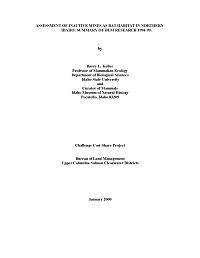Assessment of Inactive Mines as Bat Habitat in Northern Idaho: Summary of BLM Research 1994-99

Federal Lands in Idaho contain an estimated 5,000 inactive or abandoned mine sites, many with open portals. Human intrusion into these mines, whether motivated by curiosity or historical interest, subjects individuals to a variety of hazards that can prove life threatening. Consequently, inventory and closure of inactive and abandoned mines has received increased emphasis. Bats, many of which traditionally use caves and old-growth forests to roost and hibernate, may have become dependent on old mines (Tuttle and Taylor 1994). Recent colonization of mines developed during the past century could be the result of an expansion of bat habitat through selective processes enhancing metapopulations (McCullough 1996) or bats may have been displaced from their native habitat into mines as alternative roosting sites.
Additionally, some species may enter mines to feed on insects accumulating near the back at the portal. Irrespective of the factors that have caused mine use, the loss of mine habitat through closures may threaten a number of species that now appear to be mine obligates. One of these species, Townsend's big-eared bat (Corynorhinus townsendii), is generally considered the most sensitive species occupying mines in Idaho (Pierson et al. 1999). States such as Colorado have developed survey guidelines (Navo 1994) and volunteer team training manuals (Sheppard et al. nd) to assess the bat value of inactive mines. In Idaho, the Bureau of Land Management (BLM) and the Forest Service have developed an integrated approach for locating old inactive mine sites, but they have not developed a cooperative program aimed at completing biological surveys of sites slated for closure. Preliminary guidelines for the assessment of bat habitat have been prepared for the Panhandle National Forest (Keller, manuscript) because this Forest has generated an aggressive program of bat-friendly mine closures, especially at sites adjacent to Lake Pend Oreille (Keller 1997c).
A pilot inventory and mapping of inactive and abandoned mine lands (see McNary et al. nd) was funded by both the Forest Service and BLM as a result of the heavy metal contamination in the East Fork of the Pine Creek Watershed of the Silver Valley. While this inventory was in progress, the BLM sought help developing information on bat species occurring on lands they administer. The following study was initiated independently of the mine inventory to determine the suitability of inactive Silver Valley mines as potential bat habitat. The present report summarizes: 1) a research assessment of selected mine sites containing adits that could serve as summer roosting or winter hibernal habitat for bats, 2) an assessment of the species using some of these mines, and 3) characterizes the thermal envelope of several mines in the Silver Valley. The results presented here are part of an inventory of bat species being studied by the author in northern Idaho.
Most of the sites reported upon here were located on BLM lands in the Greater Coeur d'Alene mining region, an area largely bounded at the eastern edge near Mullan to the western edge near Pinehurst. Appropriate information was also gathered at other localities deemed to be important historical bat habitat. Annual reports prepared for the first three years of research effort remain unpublished (Keller 1995b; 1996; 1997a). This technical report summarizes the results of these studies and provides additional information gathered since the third report appeared in 1997.
